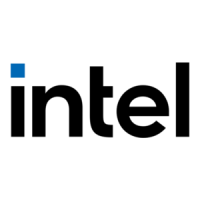Product Description
21
1.5.1.4 Flat Panel Interface (LVDS)
The flat panel interface (LVDS) supports the following:
• Panel support up to WXGA+ (1440 x 900)
• 25 MHz to 112 MHz single–channel; @18 or 24 bpp
TFT panel type
• Panel fitting, panning, and center mode
• CPIS 1.5 compliant
• Spread spectrum clocking
• Panel power sequencing
• Integrated PWM interface for LCD backlight inverter control
• Flat panel brightness control via front panel button input as well as Windows* 7
“Screen brightness” adjustment slider
1.5.1.5 Configuration Modes
For monitors attached to the VGA port, video modes supported by this board are based
on the Extended Display Identification Data (EDID) protocol.
Video mode configuration for LVDS displays is supported as follows:
• Automatic panel identification via Extended Display Identification Data (EDID) for
panels with onboard EDID support
• Panel selection from common predefined panel types (without onboard EDID)
• Custom EDID payload installation for ultimate parameter flexibility, allowing
custom definition of EDID data on panels without onboard EDID
• In addition, BIOS setup provides the following configuration parameters for internal
flat panel displays:
• Screen Brightness: allows the end user to set the screen brightness for the display
effective through the Power-On Self Test stage (such as while showing the splash
screen image and BIOS setup). Windows 7 will ignore this setting in favor of the
native “screen brightness” control provided by the operating system.
• Brightness Steps: allows the system integrator to configure the brightness steps for
the operating system’s “screen brightness” control (such as the “Screen brightness”
adjustment slider under the Windows 7 “Power Options” control panel).
• Flat Panel Configuration Changes Lock: allows the system integrator to “lock”
critical settings of the LVDS configuration to avoid end users potentially rendering
the display unusable.
• Color Depth: allows the system integrator to select whether the panel is 24 bpp or
18 bpp.
• Inverter Frequency and Polarity: allows the system integrator to set the operating
frequency and polarity of the panel inverter board.
• Maximum and Minimum Inverter Current Limit (%): allows the system integrator to
set maximum PWM%, as appropriate, according to the power requirements of the
internal flat panel display and the selected inverter board.
• Panel Power Sequencing: allows the system integrator to adjust panel sequencing
parameters, if necessary.

